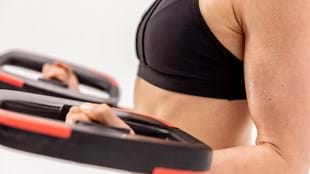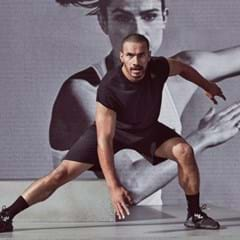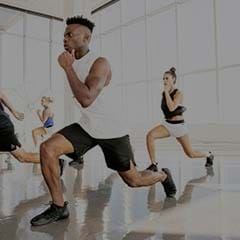Les Mills BODYPUMP™ is honestly the most brilliant way to train if you want a full body strength session, targeting the primary muscle groups that both push and pull. A push muscle is defined by fibers that contract (shorten) when weight is pushed away from the body and relax (lengthen) when weight is pulled towards the body.
The pectoralis (chest), triceps (back of the upper arm), and deltoid (shoulder) groups are all upper body push muscles. Let’s check out BODYPUMP 113 to see how all three of these push muscle groups are recruited in every dimension.
TRACK 03: CHEST
The pectoralis major is the largest chest muscle with two parts: an upper portion that originates on the clavicle (collar bone) and a lower portion on the sternum (breast bone). BODYPUMP 113 includes both a chest fly which predominantly recruits the upper fibers and a bench chest press which mainly recruits the lower fibers.
Probably the most obvious example of a pushing action is the bench chest press. This is an integrated exercise where not only the pectoralis muscles are active, but the triceps and deltoid muscles are also firing. The chest fly is also a pushing exercise but not as integrated; triceps and deltoid recruitment is significantly less.
BODYPUMP 113 COACHING TIP: There are only two rounds of bench chest press – half of the track – so encourage participants to be brave and increase their weight selection. Remind them that the pectoralis major is a large muscle and we will be engaging the arm and shoulder muscles for assistance.
TRACK 05: TRICEPS
The triceps brachii is a group of three (long, medial, lateral) muscles on the back (posterior) of the upper arm. BODYPUMP 113 includes bench pushups, overhead extensions, and dips. The reason why this release, as well as typical triceps tracks, includes multiple exercises is to ensure recruitment of all three heads.
Triceps pushups are a straightforward push exercise that elicit the greatest activity of all three heads compared to other exercises, with over 90% of the fibers recruited. Overhead extensions stimulate the medial and lateral head while dips predominantly stimulate the long head. A simple rule is that when the upper arm is close to the body, the long head generates the highest force.
BODYPUMP 113 COACHING TIP: Explain that there are multiple exercises in order to recruit all three muscles of the triceps. Be sure to introduce the combination of the bench pushup and mountain climber. This exercise pairing allows participants to successfully complete more pushup repetitions on their toes with full range, using the mountain climber as both stabilization and active recovery for the triceps.

08. SHOULDERS
The deltoid is another three head muscle group (anterior, medial, posterior) that is triangular in shape at the front, top, and back of the shoulder. The shoulders are one of the most important muscle groups because they are recruited in nearly every activity of daily life: pushing, pulling, rotation, and lifting. BODYPUMP 113 includes forward raises (anterior), side raises (medial), rear deltoid fly (posterior), and pushups (anterior) making it an integrated track to target all the shoulder components.
Interestingly, the exercise that recruits the highest percentage of all three deltoid heads in a single exercise is the plate press which is a traditional and common push exercise. Luckily, BODYPUMP 113 features this exercise in both the squat and lunge tracks, adding to the full body training effect.
BODYPUMP 113 COACHING TIP: Use the track introduction to refocus the participants. After a challenging lunge track with shoulder exercises, it is critical to enforce the importance of precision for safe technique. For example, re-state the target of shoulder height for the side and forward raise and pulling shoulder blades together while bracing the core for the standing rear fly.
INSTRUCTOR TRAINING TIPS: If you teach BODYPUMP 1-2 times per week, taking one supplementary BODYPUMP class a few times per month can be extremely beneficial to develop your own program fitness. While teaching you are thinking about the choreography, music, cues, comments, connecting and motivating. It is impossible to focus on your own strength gains with exemplary technique! Therefore, participating can provide the opportunity to concentrate on a challenging weight selection and an ideal range of motion. Of course, if you teach BODYPUMP 3 times per week, this is not the best plan as a full day of recovery between classes is essential.
In addition, completing your own weight training routine – outside of BODYPUMP – can be a complementary strategy to increase strength. As you are likely aware, individuals who weight train outside of group classes typically separate body parts or muscle function on different days. An example would be to complete pushing exercises one day and pulling exercises on a different day. If your goal is to improve BODYPUMP strength, complete the same exercises as those included in class but with more weight and fewer repetitions.
For instance, on a pushing day, perform a 5-10 minute warm-up on a rowing erg, ski erg, versaclimber, or airdyne bike. Subsequently, execute 3 sets of 15-20 repetitions of chest and shoulder presses with a bar followed by chest flys, standing triceps extensions, and shoulder raises with dumbbells. Finish with 3 sets of 20-30 repetitions of chest pushups, triceps dips, and mountain climbers.
There is an ongoing discussion between trainers, Instructors, athletes, and physical activity enthusiasts about optimal strength exercises for an integrated full body workout. Be an educated contributor to the conversation! Les Mills BODYPUMP continues to deliver a quality combination of exercises that target each component of the primary muscle groups.
Gottschall et al, 2019; Kholinne et al, 2018; Soncin et al, 2014; Sweeney et al, 2014
Jinger S. Gottschall, Ph.D. earned her doctorate degree in integrative physiology from the University of Colorado at Boulder. She furthered her academic career as a postdoctoral fellow in neurophysiology at the Emory School of Medicine and as an Associate Professor in kinesiology at The Pennsylvania State University. Dr. Gottschall is currently an Adjunct Associate Professor in the Department of Biobehavioral Science at Columbia University. She was also the founder and co-owner of FITOLOGY, a Les Mills group fitness studio. A passionate advocate for physical activity, Dr Gottschall has dedicated her career to finding programs that promote balanced, healthy lifestyle choices while delivering the results they promise.








